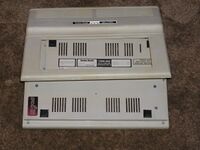Chemistry:Retr0bright
Retrobright (stylized as retr0bright or Retrobrite), is a chemical process used to remove 'yellowing' from acrylonitrile butadiene styrene (ABS) plastics.[1]
The original meaning has been expanded, so now "retrobright" often refers to indicate any H2O2 based process used to remove yellowing from ABS plastics. The usage has also expanded to other retro restoration applications, such as classic and collectible sneaker restoration.[citation needed]
Yellowing in ABS plastic occurs when it is exposed to UV light or excessive heat, which causes photo-oxidation of polymers that breaks polymer chains and causes the plastic to yellow and become brittle.[2] The method of reversing the yellowed discoloration was first discovered in 2007 in a German retrocomputing forum,[3] before spreading to an English blog where it was further detailed.[4][5][6] The process has been continually refined since.[1]
There is still some debate over the long-term effectiveness of this technique. Some have discovered the yellowing reappears, and there are concerns that the process weakens and only bleaches the already damaged plastic.[7][8][9]
Composition
Retrobright consists of hydrogen peroxide, a small amount of the "active oxygen" laundry booster TAED as a catalyst, and a source of UV.[10]
The optimum mixture and conditions for reversing yellowing of plastics:
- A hydrogen peroxide solution.[11]
- Approximately 1 ml per 3 liters (1 part in 3000 by volume, alternatively 1⁄4 teaspoonful per US gallon) of tetraacetylethylenediamine (TAED)-based laundry booster (concentrations of TAED vary).
- A source of ultraviolet light,[11] from sunlight or a UV lamp.[10]
Xanthan gum or arrowroot can be added to the mixture, creating an easier-to-apply gel. In addition to homemade gel mixtures, hydrogen peroxide-based hair bleaching creams available at beauty supply stores can also be used as a ready-made mix.
Certain beauty salon products that are primarily composed of hydrogen peroxide can also be used as an alternative to retrobright, as it has been discovered to be almost identical in effect, and already viscous so that it can be applied less wastefully to yellowed plastics (especially large devices such as computer panels or monitors).[12][13] While this eliminates the difficulty of having to put together a batch directly from the instructions,[13] one must be careful to apply the cream and wrap consistently and evenly to avoid streaks in the final product.[14]
Sodium percarbonate may also be used by dissolving it in water and following the usual steps for hydrogen peroxide, as it is sodium carbonate and hydrogen peroxide in a crystalline form.[11]
Ozone gas can also be used for retrobrighting, as long as an ozone generator, a suitable container of sufficient size and a source of UV are available, but can take longer than other methods.[11] It must also be noted that ozone is a dangerous substance and knowledge and understanding of proper handling protocols as per the MSDS are critical.[15]
References
- ↑ 1.0 1.1 Ángel Jiménez de Luis (May 25, 2010). "Retr0bright lava más blanco". http://www.elmundo.es/blogs/elmundo/el-gadgetoblog/2010/05/25/retr0bright-lava-mas-blanco.html.
- ↑ Yousif, E.; Haddad, R. (August 23, 2013). "Photodegradation and photostabilization of polymers, especially polystyrene: review". SpringerPlus 2: 398. doi:10.1186/2193-1801-2-398. PMID 25674392.
- ↑ "Forum64 — Restaurierung eines C-64G, oder das Gastgeschenk des DOC64". February 19, 2007. https://www.forum64.de/index.php?thread/14918-restaurierung-eines-c-64g-oder-das-gastgeschenk-des-doc64/&postID=139741#post139741.
- ↑ "The "Retr0bright" Project". July 28, 2010. http://retr0bright.wikispaces.com:80/.
- ↑ Doctorow, Cory (March 2, 2009). "Open source computer polish: Retr0Brite". http://www.boingboing.net/2009/03/02/open-source-computer.html.
- ↑ Mossesgeld, Rico (July 28, 2010). "How To Restore Your Beige Retro Hardware". Tom's Hardware. https://www.tomsguide.com/us/retr0bright-hardware-restoration,news-7595.html.
- ↑ Stewart, Terry (January 17, 2013). "Retr0Bright (or RetroBright) treated plastics re-yellowing even with minimal light exposure?". http://www.classic-computers.org.nz/blog/2013-01-15-retr0bright-only-temporary.htm.
- ↑ Petersen, Anja Liss (January 19, 2011). "Afrensning af plast med RetrObright" (in danish). http://aktuelbevaring.natmus.dk/afrensning-af-plast-med-retrobright.html.
- ↑ Flood, David (April 14, 2018). "A Look into the Yellowing and Deyellowing of ABS Plastics". https://medium.com/@pueojit/a-look-into-the-yellowing-and-deyellowing-of-abs-plastics-db14b646e0ad.
- ↑ 10.0 10.1 Maushammer, John (March 2, 2009). "Un-Yellow Old Plastics – Retr0brite!". https://makezine.com/2009/03/02/unyellow-old-plastics-retr0brite/.
- ↑ 11.0 11.1 11.2 11.3 Murray, David (20 August 2017). "Adventures in Retrobrite - New techniques for restoring yellowed plastic!". https://www.youtube.com/watch?v=qZYbchvSUDY. Retrieved 26 November 2019.
- ↑ Narcisse, Evan (September 24, 2014). "The Secret To Keeping Old Consoles Looking New? Hair Product.". https://kotaku.com/super-strong-hair-product-is-the-secret-to-get-old-cons-1638537069.
- ↑ 13.0 13.1 Murray, David (April 6, 2013). How to fix yellowed plastics on old computers!. The 8-Bit Guy. Archived from the original on 2021-12-15. Retrieved May 29, 2017.
- ↑ "How Retrobright Works! - The Geek Pub" (in en-US). The Geek Pub. May 27, 2018. https://www.thegeekpub.com/13216/how-retrobright-works/.
- ↑ MSDS: https://www.about-ozone.com/material-safety-data-sheet-msds-of-ozone/
External links



